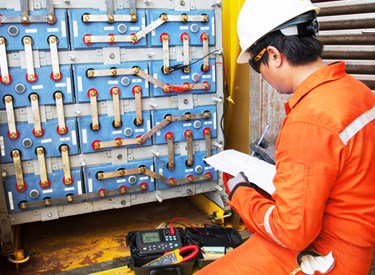Target Groups
These programmes are designed to meet the initial onshore training and validation requirements for personnel preparing to work as Authorised Gas Testers for a variety of products and work environments.
JMS Consultants work with clients to tailor training to the client’s specific needs across many sectors including exploration and production oil and gas companies, petrochemical and shipping companies, pharmaceutical companies, steel producers, tank cleaning and vessel inspection companies.
Authorised Gas Tester is required for those involved with performing a test for oxygen, flammable and toxic gases up to and including working in confined spaces, for those involved with testing for flammable gases in preparation for hot work and for those who provide safety watch duties by the ongoing monitoring of a hot work site.
NOTE: In the workplace, persons undertaking Standby/Safety Watch duties at the entrance to a confined space shall be an Authorised Gas Tester or Gas Monitor.
Delegate Prior Achievement
There are no delegate pre-requisites for attendance on this course.
Physical & Stressful Demands of the Courses
All personnel who participate in gas testing training should be medically fit and capable of participating fully. The responsibility for the individual completing the course, without any adverse effects to their present state of health, lies with the delegate and/or the company sponsoring the delegate.
Performance Validations
Delegates attending these training and validation programmes will be given a series of explanations and demonstrations which will identify what they are expected to know and do.
Modules Summary and Training Outcomes
During the initial training programme, delegates will gain an understanding of the roles and responsibilities of an Authorised Gas Tester.
The training course consists of the following modules and elements:
Module 1 – Authorised Gas Tester
- Element 1.1 Relevant legislative controls
- Element 1.2 Atmosphere measuring and monitoring equipment
- Element 1.3 Interpreting and documenting the results
Module 2 – Testing for flammable gas in preparation for hot work
- Element 2.1 Gas Testing for hot work
Module 3 – Confined Space Testing
- Element 3.1 Gas testing in confined spaces
Module 4 – Gas Monitoring for Hot Work Sites
- Element 4.1 Providing safety watch duties for hot work sites
On Completion
On successful completion of the training, the delegate will be able to demonstrate an understanding of:
Module 1 – Authorised Gas Tester
- Confined space criteria
- The type of operations being tested for flammable and toxic gases
- The hazards of operations within an oxygen-enriched, oxygen-deficient, toxic or flammable environment
- Carrying out a suitable and sufficient risk assessments
- Understand the safe systems of work, how to work within the safe system of work and the associated responsibilities
- The implications of statutory and organisational requirements
- Interpreting operational requirements
- How to select, use and care for PPE and RPE
- Accessing and interpreting operational instructions
- The operating principles of atmosphere monitoring and measuring equipment and failure modes
- The strengths and weaknesses of various types of atmospheric flammable and toxic gas detection equipment
- Correct selection of aspirating or non-aspirating detectors to obtaining representative atmosphere sample
- Equipment required for testing for hydrocarbons in inert atmospheres
- Gas detector pre-start checks
- Determining the extent of the test boundaries
- Calibrating the instruments used in atmospheric testing
- Sources of assistance during the event of damaged or defective equipment
- Interpreting normal and abnormal results
- Documenting the results and advising relevant personnel
Module 2 – Testing for flammable gas in preparation for hot work
- Hot work (any operation involving naked flames or producing heat and/or sparks or any operation that has spark potential)
- Type of operations being tested for flammable and toxic gases
- The principles of hot work gas testing
- The hazards and properties of flammable gases
- Acceptable levels of flammable gases and the correct amount of oxygen
- Carrying out a suitable and sufficient risk assessment
- Using safe systems of work and understanding the associated responsibilities
- The implications of organisational and statutory requirements
- Detectors used for the flammable product
- How to set up the relevant detectors for each gas testing application and confirm functioning correctly
- The range and frequency of tests and monitoring and retesting requirements
- Where to site portable or transportable equipment that will be used to continuously monitor the atmosphere
Module 3 – Confined space testing
- The hazards and properties of flammable and toxic gases
- The behaviour of different gases
- The range and frequency of tests and monitoring and retesting requirements after initial entry
- Acceptable levels of flammable gases and the correct amount of oxygen
- The implications of WEL for toxic gases and LEL for flammable gases
- How to set up the relevant detectors for each gas testing application and confirm functioning correctly
- Performing gas tests in sequential order
- How to obtain representative atmosphere sample
- Taking various samples to locate varying concentrations of gases and vapours
- Importance of sampling confined spaces at a distance
- Testing flammable gases in inert atmospheres
- Where to site portable or transportable equipment that will be used to continuously monitor the atmosphere
Module 4 – Gas monitoring for hot work sites
- Hot work (any operation involving naked flames or producing heat and/or sparks or any operation that has spark potential)
- Confined space criteria
- The type of operations being tested for flammable and toxic gases
- Roles and responsibilities of the Fire Watch
- Roles and responsibilities of the Stand-By person
- Responsibilities of the Gas Monitor role
- How to select, use and care for PPE
- How to work within the safe system of work
- The hazards and properties of flammable gases
- The behaviour of different flammable and toxic gases
- The potential arrival of flammable gas or vapour clouds at the hot work site
- Impact of environmental changes on working conditions
- Importance of checking controls on the equipment are as specified
- Importance of regular communication
- Sources of assistance and specialist support
- Completion of relevant documentation
PPE will be required (Hard hat, steel toe capped boots & glasses). Please ensure arms and legs are covered.
Validation of the delegates’ performance will be against the stated Training Outcomes and will be achieved using a combination of Multiple-Choice Questionnaires and, where appropriate, observation/questioning during a practical exercise.
Delegates successfully completing the course validation will be judged to have met the learning outcomes for the Authorised Gas Tester standard. They should proceed to the workplace for site-specific assessment under the direct supervision of a competent person.


